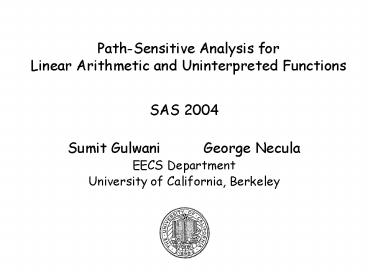Path-Sensitive Analysis for Linear Arithmetic and Uninterpreted Functions - PowerPoint PPT Presentation
1 / 17
Title:
Path-Sensitive Analysis for Linear Arithmetic and Uninterpreted Functions
Description:
V(Guard(g,f)) = H(g)*V(f) H: Guard ! Integer. H(true) = 1, H ... V(Guard(g,f)) = H(g) V(f) V(F(f1,f2)) = V(f1) M V(f2) N. M, N: random k k matrices ... – PowerPoint PPT presentation
Number of Views:17
Avg rating:3.0/5.0
Title: Path-Sensitive Analysis for Linear Arithmetic and Uninterpreted Functions
1
Path-Sensitive Analysis for Linear Arithmetic
and Uninterpreted Functions
- SAS 2004
- Sumit Gulwani George Necula
- EECS Department
- University of California, Berkeley
2
Example
All 3 asserts are true
False
True
a2?
x a y 2
x 2 y a
True
False
a2?
u 1 v 1a
u a-1 v 3
t1 x-u t2 v-y
Assert(t1t2 Æ t11 Æ y2)
3
Path-Insensitive Analysis
- Most PTIME analyses treat conditionals as
non-deterministic. - They will verify only t1t2
False
True
x a y 2
x 2 y a
True
False
u 1 v 1a
u a-1 v 3
t1 x-u t2 v-y
Assert(t1t2 Æ t11 Æ y2)
4
Path-Sensitive Analysis
- We can do better by modeling conditionals as
boolean formulas. - Each atomic predicate is abstracted to a boolean
variable - They will also verify t11
- This is still abstract though!
- y2 not verified
- undecidable to reason completely
False
True
c1
x a y 2
x 2 y a
True
False
c1
u 1 v 1a
u a-1 v 3
t1 x-u t2 v-y
Assert(t1t2 Æ t11 Æ y2)
5
Multi-Valued ROBDDs (MVRs)
c1
t1
True
False
c1
c2
c1
x
c2
u
c2
x a y 2
x 2 y a
1
a
0
a-1
1
-a3
a-1
1
True
False
c2
- MVR(t1) MVR(x) MVR(u)
- MVR(t1) does not share nodes with MVR(x) and
MVR(u) - Need a normal form for leaves
u 1 v 1a
u a-1 v 3
t1 x-u t2 v-y
Assert(t1t2) Assert(t11)
6
Free Conditional Expression Diagrams (FCEDs)
-
t1
True
False
c1
c1
x
c2
u
x a y 2
x 2 y a
1
a
0
a-1
True
False
c2
- FCED(t1) FCED(x) FCED(u)
- FCED(t1) shares nodes with FCED(x) and FCED(u)
- No need for normal form
u 1 v 1a
u a-1 v 3
t1 x-u t2 v-y
Assert(t1t2) Assert(t11)
7
- FCEDs for Linear Arithmetic
8
FCED Construction
Formalization
c1
c2
1
a
0
a-1
- FCED(x) Leaf(x)
- FCED(n) Leaf(n)
- FCED(e1e2) Plus (FCED(e1), FCED(e2))
- FCED(if b then e1 else e2)
Choose(R(b),FCED(e1), NOT R(b), FCED(e2))
9
Normalize Guard Operator
g,f Guard(g,f), if BV(g) lt BV(f) g,
Plus(f1,f2) Plus(g,f1, g, f2) g,
Choose(f1,f2) Choose(g,f1, g,
f2) g1, Guard(g2,f ) Guard(
INTERSECT(g1,g2),f )
10
Example Normalize Guard Operator
Given f, construct R(c1),f
Plus
choose
choose
guard
guard
guard
guard
guard
guard
R(c1)
R(c1)
z
6
R(c2)
R(c2)
R(c1)
R(c1)
3
2
R(c1Æc1)
R(c1Æc1)
11
Randomized Equivalence Testing for FCEDs
- Assign hash values to nodes of FCEDs in bottom-up
manner - V FCED Node ! Integer
- V(Leaf(n)) n
- V(Leaf(x)) rx
- V(Plus(f1,f2)) V(f1) V(f2)
- V(Choose(f1,f2)) V(f1) V(f2)
- V(Guard(g,f)) H(g)V(f)
- H Guard ! Integer
- H(true) 1, H(false) 0
- H(c) rc
- H(If(c,g1,g2)) rc H(g1) (1-rc) H(g2)
12
Randomized Equivalence Testing for FCEDs
- Completeness
- f1 f2 ) V(f1) V(f2)
- Soundness
- f1 f2 ) PrV(f1) V(f2) s/t
- s maximum of nodes in a FCED
- t size of set from which random values are
chosen - Proof 9 1-1 Poly FCED ! Polynomials such that
V(f) is the value of Poly(f)
13
- FCEDs for Uninterpreted Functions
14
FCED Construction
- FCED(x) Leaf(x)
- FCED(F(e1,e2)) F(FCED(e1), FCED(e2))
- FCED(if b then e1 else e2) Choose(R(b),FCED(e1
), NOT R(b), FCED(e2))
15
Randomized Equivalence Testing of FCEDs
- Assign hash values to nodes of FCEDs in bottom-up
manner - V FCED Node ! Tuple of k integers
- K depth of any FCED
- V(x) rx,rx
- V(Choose(f1,f2)) V(f1) V(f2)
- V(Guard(g,f)) H(g) V(f)
- V(F(f1,f2)) V(f1) M V(f2) N
- M, N random k k matrices
16
Randomized Equivalence Testing for FCEDs
- Completeness
- f1 f2 ) V(f1) V(f2)
- Soundness
- f1 f2 ) PrV(f1) V(f2)
- s maximum of nodes in a FCED
- t size of set from which random values are
chosen - Proof more involved
17
Conclusion and Future Work
- Randomization can help achieve simplicity and
efficiency at the expense of making soundness
probabilistic - Other interesting possible extensions
- Combination of uninterpreted functions with
arithmetic - Partially interpreted functions like associative
functions - Memory
- Inequalities

